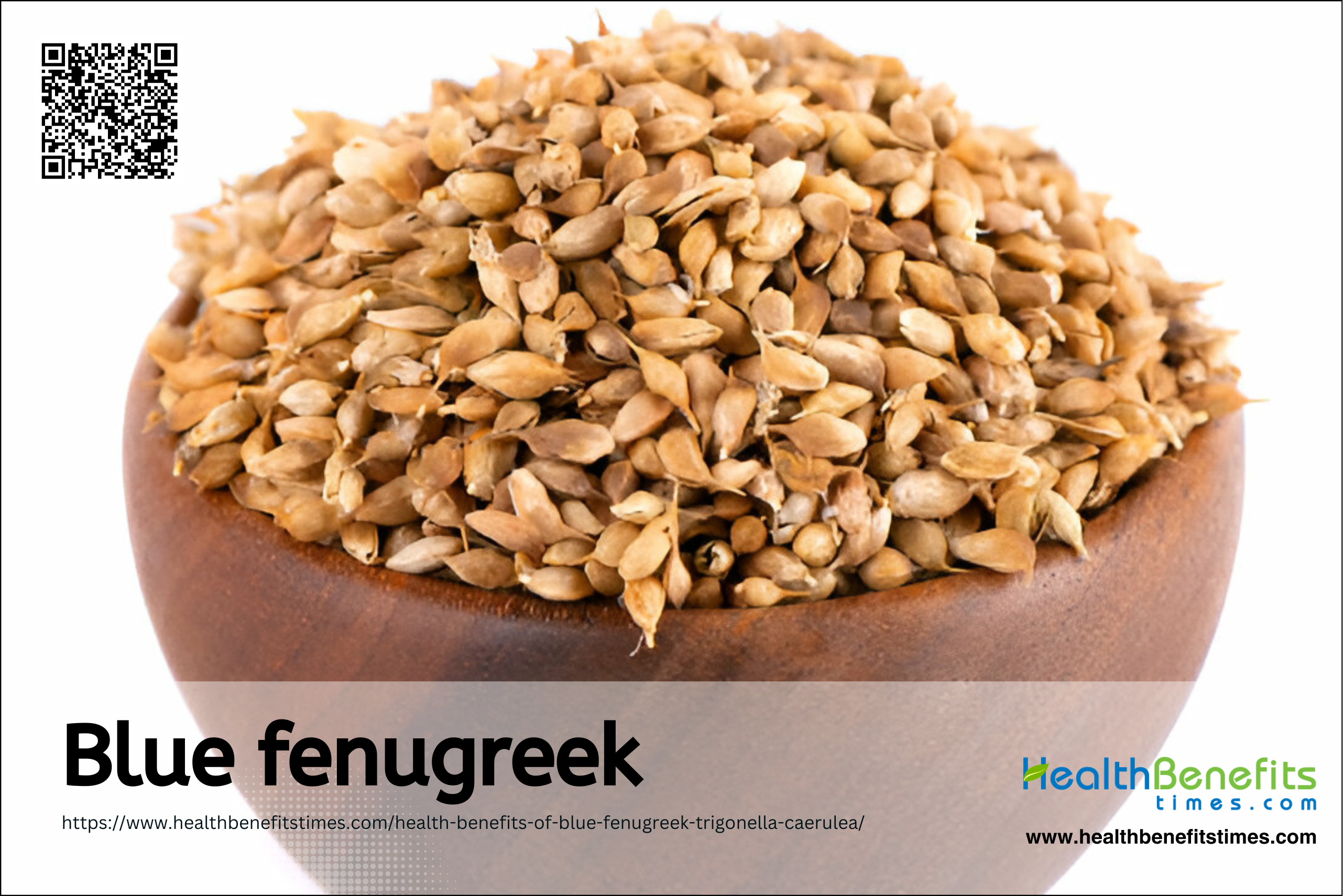 Blue fenugreek (Trigonella caerulea) is an aromatic herbaceous plant from the Fabaceae family, primarily used in traditional cheese and bread production in the Alpine region. It is distinct from the more commonly known fenugreek (Trigonella foenum-graecum), although they share the same genus. It’s primarily cultivated in the mountain regions of Eastern and Central Europe. Blue fenugreek has a unique phytochemical composition that contributes to its characteristic aroma and potential health benefits. While it may be less known than its yellow-flowered cousin, blue fenugreek has its own unique set of culinary and medicinal applications that are treasured in various cultures.
Blue fenugreek (Trigonella caerulea) is an aromatic herbaceous plant from the Fabaceae family, primarily used in traditional cheese and bread production in the Alpine region. It is distinct from the more commonly known fenugreek (Trigonella foenum-graecum), although they share the same genus. It’s primarily cultivated in the mountain regions of Eastern and Central Europe. Blue fenugreek has a unique phytochemical composition that contributes to its characteristic aroma and potential health benefits. While it may be less known than its yellow-flowered cousin, blue fenugreek has its own unique set of culinary and medicinal applications that are treasured in various cultures.
Overview of its origins and traditional uses
Blue fenugreek, belonging to the Fabaceae family, is commonly used in the Alpine region for making unique cheese and bread types. It has a distinctive scent that flavors these foods. Through various analyses, researchers have identified primary and specialized compounds in the herb, like fatty acids, α-keto acids, and volatile elements such as tiglic aldehyde and phenylacetaldehyde, giving it its special aroma. While it’s similar to fenugreek, known for its use in Ayurvedic, Tibetan, and Chinese medicine, blue fenugreek has its own identity and uses. Both plants have a history of medicinal use, with current studies supporting their potential in treating conditions like diabetes and high cholesterol, and their applications in the pharmaceutical and nutraceutical industries.
Highlight its increasing popularity as a super food
Blue fenugreek, also known as Trigonella caerulea, stands out from the more common fenugreek (Trigonella foenum-graecum) for its exceptional health benefits and medicinal properties. Although the research primarily focuses on Trigonella foenum-graecum, it underscores the plant’s impressive nutritional value, including essential phytochemicals, dietary fiber, and bioactive compounds like galactomannan, diosgenin, and isoleucine. These elements play a key role in fenugreek’s ability to combat diabetes, boost antioxidants, and lower cholesterol levels, making it a hot topic in pharmaceuticals, nutraceuticals, and functional foods. Notably, fenugreek seeds have demonstrated the potential to regulate glucose metabolism, suggesting a promising way to manage blood sugar levels. Given the similarities between the two plants, it’s likely that blue fenugreek shares these health-boosting qualities, solidifying its reputation as a superfood.
Nutritional value of Blue Fenugreek
Blue Fenugreek seeds stand out for their high fiber content, which helps regulate glucose metabolism and can assist in managing blood sugar levels. They are also a good source of essential amino acids, such as leucine, lysine, and tryptophan, which are vital for various bodily functions. These seeds contain a range of vitamins like A, B1, B2, C, and minerals such as iron, calcium, and phosphorus, making them a valuable addition to your diet. Moreover, Blue Fenugreek seeds are packed with phytochemicals like flavonoids, saponins, and alkaloids, known for their antidiabetic, antioxidant, and hypocholesterolemic properties. These elements contribute to the overall health benefits of the seeds, potentially offering anti-inflammatory and digestive health effects. Additionally, these seeds are a source of healthy fats, including oleic acid, linolenic acid, and linoleic acid, which are crucial for heart health. In summary, Blue Fenugreek seeds provide a mix of nutritional value and medicinal properties that can benefit both human and animal health.
Health Benefits of Blue Fenugreek
1. Blood Sugar Management
Blue fenugreek has been studied for its potential in managing blood sugar levels. Research has shown that the alcoholic extract of fenugreek seeds can significantly reduce blood glucose in both normal and diabetic rats. Another study found that fenugreek seed powder could improve glucose homeostasis by reversing altered enzyme activities related to glucose and lipid metabolism in diabetic rat tissues. Additionally, the soluble dietary fiber fraction of fenugreek seeds has been reported to delay carbohydrate digestion and absorption, thereby improving glucose tolerance in animal models of diabetes. These findings suggest that fenugreek, including blue fenugreek, may offer beneficial effects in the management of blood sugar levels, potentially aiding in the control and management of diabetes.
2. Lower cholesterol level
The soluble dietary fiber portion of Trigonella foenum-graecum could notably lower fructosamine levels and harmful lipids like triglycerides, cholesterol, and LDL-cholesterol, while boosting HDL-cholesterol in Type 2 diabetic rats. Another study revealed that varying doses of Trigonella foenum-graecum whole seed powder enhanced the lipid profile in diabetic mice, indicating a potential for reducing lipids. Furthermore, Trigonella stellata, a different species in the same genus, has been found to ease oxidative stress and revive antioxidant enzyme activities, indirectly impacting lipid metabolism. Moreover, a mix of Trigonella foenum and Cinnamon was shown to standardize lipid profiles in diabetic rats. Finally, an aqueous extract of Trigonella foenum-graecum seeds displayed a safeguarding effect against monosodium glutamate-induced dyslipidemia and oxidative stress. These discoveries collectively suggest that blue fenugreek and its relatives may offer positive effects on cholesterol levels and overall lipid metabolism, which could be beneficial in managing conditions like diabetes and associated dyslipidemia.
3. Support weight loss
It is suggest that fenugreek seeds could impact metabolic functions and play a role in addressing metabolic disorders. For example, a study on Zucker obese rats, which are used as an obesity model, revealed that supplementing with fenugreek seeds might lower liver triglyceride accumulation, a key feature of hepatic steatosis, without affecting insulin or glucose levels in the blood, hinting at potential support for weight loss. Moreover, a fenugreek seed extract was observed to decrease spontaneous fat intake in overweight individuals, resulting in a small yet notable reduction in dietary fat consumption, which could aid in weight control. While these findings show promise, more research is necessary to fully grasp how blue fenugreek specifically affects weight loss and the underlying mechanisms.
4. Soothing Inflammation
Blue fenugreek, although not directly studied in the papers provided, is closely associated with Trigonella foenum-graecum and Trigonella gharuensis. These two have shown remarkable anti-inflammatory properties. Studies reveal that Trigonella foenum-graecum seeds oil (TgSO) can reduce inflammation and angiogenesis by lowering TNF-α and increasing antioxidant enzymes like superoxide dismutase (SOD) and catalases (CAT). In vivo studies support this by demonstrating that TgSO significantly decreases swelling in different models and displays antiangiogenic effects, confirming its traditional use as an anti-inflammatory herb. Similarly, extracts from Trigonella gharuensis can hinder inflammation in various in vivo models, hinting at the suppression of autacoids, which are mediators of inflammation. These discoveries imply that blue fenugreek, due to its chemical similarities with these species, might also have calming anti-inflammatory properties.
5. Improve sexual health
Studies on the closely related Trigonella foenum-graecum have shown positive results in improving sexual health. For example, a study on women with low sexual drive revealed that a special fenugreek seed extract called Libifem notably boosted free testosterone and estradiol levels. This increase was linked to higher sexual desire and arousal. It’s worth noting that fenugreek may have some adverse effects like testicular toxicity and reduced fertility in males, as well as fertility issues and abortifacient properties in females. Therefore, caution is advised when using fenugreek. More research is necessary to understand if blue fenugreek offers similar sexual health advantages and drawbacks.
6. Improve women’s health
A special extract of fenugreek seeds called Libifem has been found to boost free testosterone and estradiol levels, enhancing sexual desire in healthy women. Fenugreek seed extract has also shown protective effects against lead acetate toxicity in female rats, hinting at its potential as a dietary supplement with antioxidant properties. Moreover, fenugreek is known for its anti-inflammatory and milk production-boosting effects, which could support women’s health needs. A new extract of fenugreek seeds has been shown to relieve symptoms like hot flashes and depression in perimenopausal women, offering promise for managing menopausal discomforts. Lastly, fenugreek has been linked to increased milk production in breastfeeding women, a potential advantage for nursing mothers. While these studies shed light on fenugreek’s benefits for women, the specific effects of blue fenugreek may differ and warrant further exploration.
7. Alleviate Gastrointestinal Discomfort
Blue fenugreek, known as Trigonella caerulea, offers a traditional remedy for easing digestive discomfort. While there aren’t specific studies on this herb, we can learn from similar compounds and plants. For example, caerulein, found in a related plant, can impact intestinal movement, potentially aiding those with gastrointestinal disorders. Trigonelline, a key component in the more familiar Trigonella foenum-graecum, shows promise in managing blood sugar levels and protecting the brain, which could indirectly help with digestive issues, especially in diabetic individuals. However, we need more research to understand how Trigonella caerulea directly influences digestive problems and its overall effectiveness.
8. Relief from Reproductive System Issues
Blue fenugreek has been researched for its potential in addressing reproductive system issues. Studies revealed that Trigonella tibetana seeds can bring about significant changes in the ovary, including increasing the number and size of follicles. This suggests a possible impact on early fertility. Moreover, research on male albino rats found that the ethanolic extract of Trigonella foenum-graecum seeds may act as an antispermatogenic and antifertility agent by hindering spermatogenesis and mating ability. These results underscore the varied effects of Trigonella species on different animals’ reproductive systems, prompting further exploration of their mechanisms and potential therapeutic uses.
How to Incorporate Blue Fenugreek in your diet
Blue Fenugreek offers a unique and milder taste compared to regular fenugreek, making it a fantastic addition to your cooking. You can sprinkle it as a spice in dishes like soups, stews, and curries to give them a subtle bittersweet twist. It also pairs perfectly with cheese-making, particularly in traditional European cheeses, where it brings a distinct flavor. You can even bake it into bread or mix it into spice blends to add a touch of the Caucasus to your kitchen. Whether you want to spice up your meals or try out some traditional Georgian recipes, Blue Fenugreek is a versatile ingredient that can take your cooking to the next level.
Potential Side Effects and Contraindications
Trigonella caerulea is generally considered safe for culinary uses, but like its relative common fenugreek (Trigonella foenum-graecum), it may have potential side effects and contraindications. Individuals with allergies to plants in the Fabaceae family, such as peanuts and chickpeas, should exercise caution due to possible allergic reactions. Additionally, due to its effects on blood sugar levels, blue fenugreek might interact with diabetes medications, potentially enhancing the production of insulin under hyperglycemic conditions. Pregnant women should avoid using blue fenugreek in medicinal amounts as it may stimulate menstrual flow and potentially act as an abortifacient. While specific studies on blue fenugreek are limited, these potential risks suggest that individuals with allergies, those on diabetes medications, and pregnant women should use this herb cautiously.


